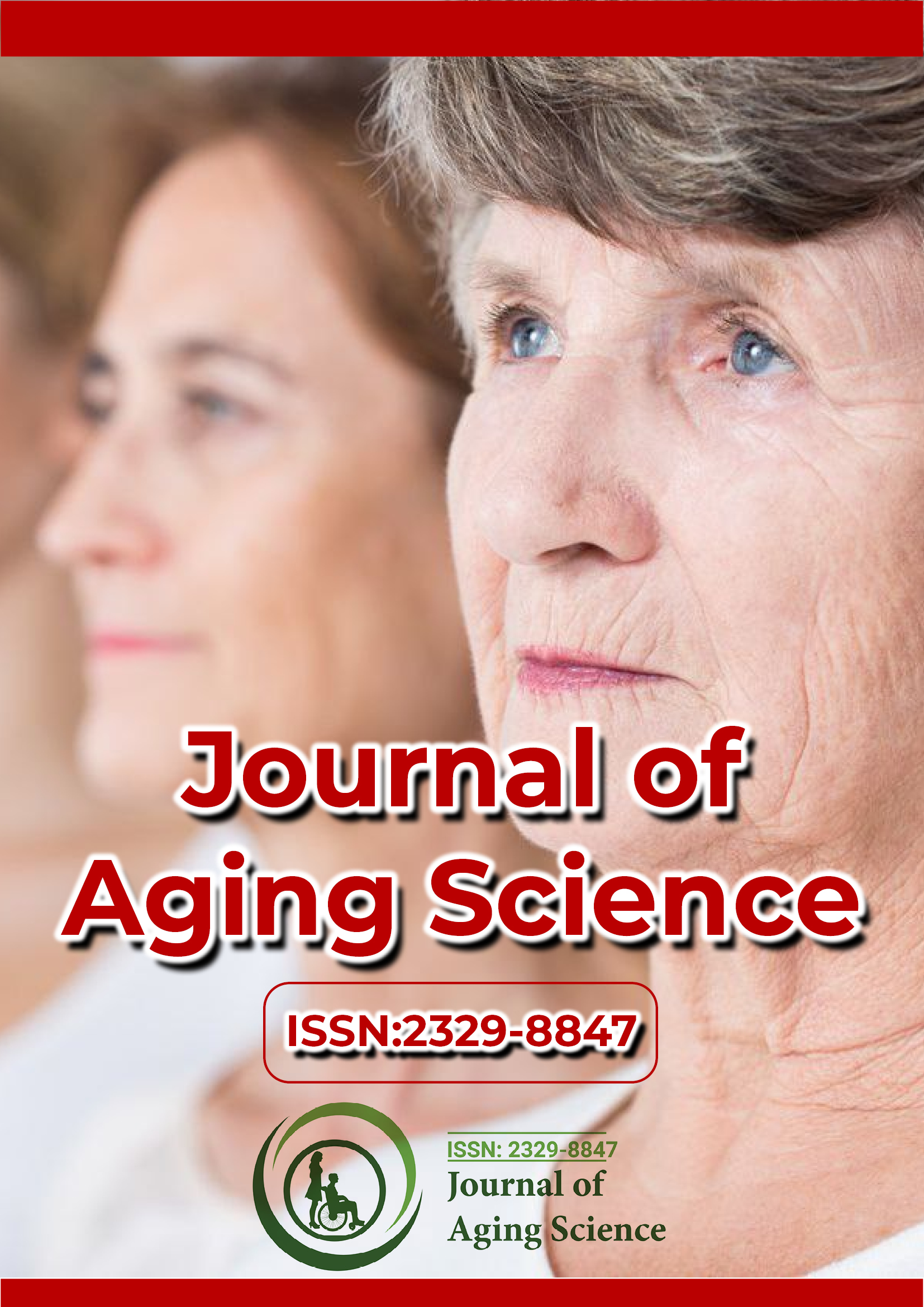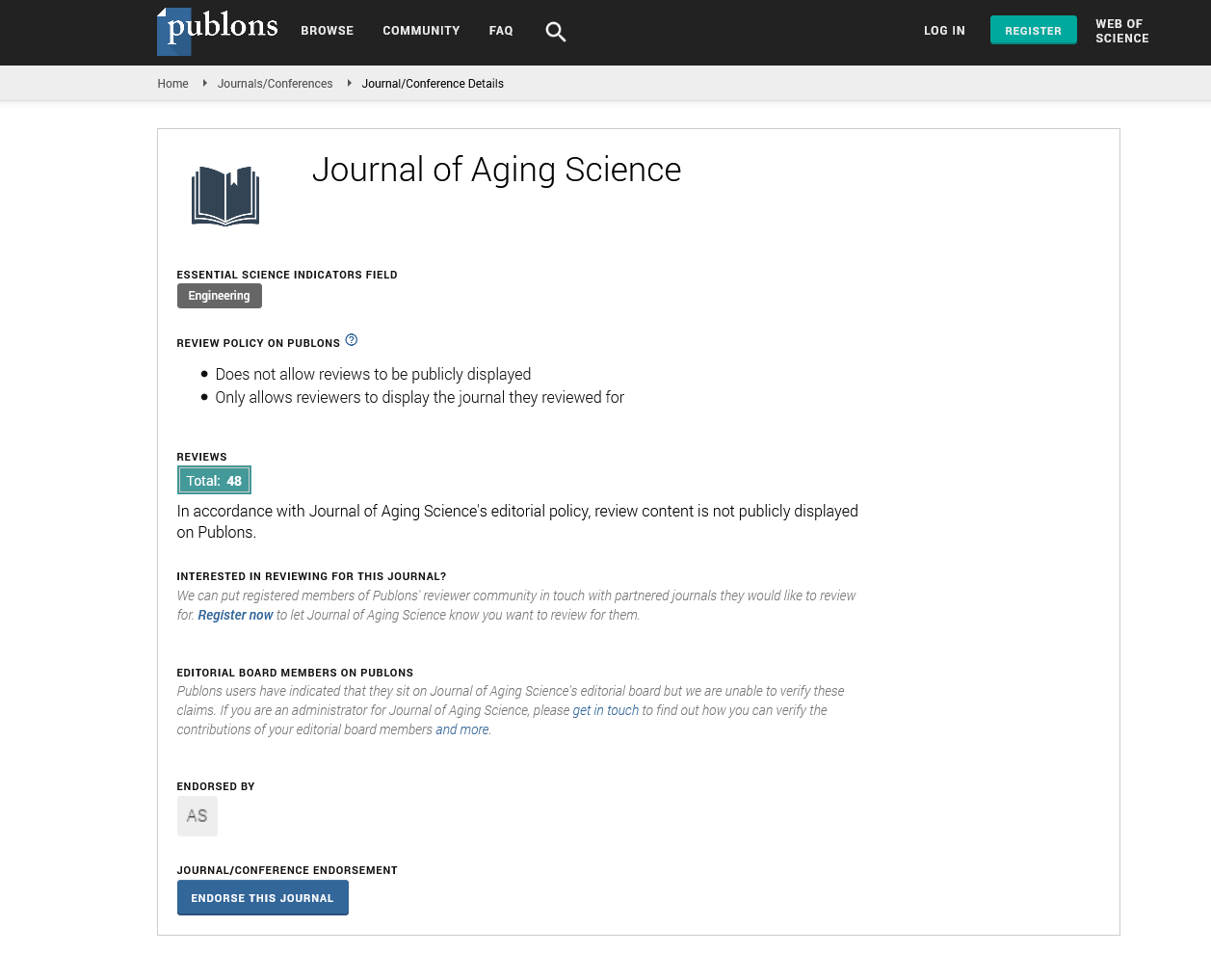Indexed In
- Open J Gate
- Academic Keys
- JournalTOCs
- ResearchBible
- RefSeek
- Hamdard University
- EBSCO A-Z
- OCLC- WorldCat
- Publons
- Geneva Foundation for Medical Education and Research
- Euro Pub
- Google Scholar
Useful Links
Share This Page
Journal Flyer

Open Access Journals
- Agri and Aquaculture
- Biochemistry
- Bioinformatics & Systems Biology
- Business & Management
- Chemistry
- Clinical Sciences
- Engineering
- Food & Nutrition
- General Science
- Genetics & Molecular Biology
- Immunology & Microbiology
- Medical Sciences
- Neuroscience & Psychology
- Nursing & Health Care
- Pharmaceutical Sciences
Perspective - (2025) Volume 13, Issue 1
Stem Cell Exhaustion and Tissue Regeneration in Aging
Charles Gordon*Received: 27-Feb-2025, Manuscript No. JASC-25-28487; Editor assigned: 01-Mar-2025, Pre QC No. JASC-25-28487 (PQ); Reviewed: 07-Mar-2025, QC No. JASC-25-28487; Revised: 14-Mar-2025, Manuscript No. JASC-25-28487 (R); Published: 28-Mar-2025, DOI: 10.35248/2329-8847.25.13.399
Description
Aging is a complex biological process characterized by the gradual decline of physiological functions, increased susceptibility to diseases and diminished regenerative capacity. A critical contributor to these changes is stem cell exhaustion, a phenomenon where stem cells lose their ability to self-renew and differentiate effectively. Stem cells play a pivotal role in tissue homeostasis and repair and their dysfunction significantly impacts the aging process. This article explores the mechanisms of stem cell exhaustion, its effects on tissue regeneration and potential interventions to mitigate its impact on aging.
Stem cell exhaustion: Mechanisms and causes
Stem cell exhaustion is driven by a combination of essential and extrinsic factors that impair the regenerative potential of tissues. These include:
Telomere shortening: Telomeres, the protective ends of chromosomes, shorten with each cell division. Once telomeres reach a critically short length, stem cells enter senescence or undergo apoptosis, reducing their availability for tissue repair.
DNA damage and genomic instability: Accumulation of DNA damage over time due to environmental stressors, oxidative stress and replication errors leads to impaired stem cell function. This results in reduced regenerative potential and increased cellular dysfunction.
Epigenetic changes: Aging is associated with epigenetic modifications, such as DNA methylation and histone modifications, which alter gene expression patterns in stem cells, leading to their dysfunction.
Decline in niche support: Stem cell niches provide critical signals for stem cell maintenance and function. Aging alters the microenvironment, reducing the availability of necessary growth factors and extracellular matrix components, leading to decreased stem cell activity.
Chronic inflammation: Aging is characterized by a state of lowgrade chronic inflammation, often referred to as "inflammaging." Pro-inflammatory cytokines disrupt stem cell function, promote cellular senescence and impair tissue regeneration.
Metabolic dysregulation: Changes in mitochondrial function and nutrient-sensing pathways, such as reduced activity of sirtuins and AMP-Activated Protein Kinase (AMPK), affect stem cell energy metabolism and overall regenerative capacity.
Impact of stem cell exhaustion on tissue regeneration
As stem cells lose their regenerative capacity, various tissues and organs experience functional decline. This contributes to the development of age-related disorders and impaired wound healing.
Hematopoietic Stem Cells (HSCs) and immune aging:
Hematopoietic stem cells, responsible for blood cell production, become less efficient with age, leading to a weakened immune system. This results in increased susceptibility to infections, reduced vaccine efficacy and a higher risk of hematological disorders.
Mesenchymal Stem Cells (MSCs) and skeletal aging: MSCs plays an important role in maintaining bone and cartilage integrity. Their decline leads to osteoporosis, reduced fracture healing and increased risk of osteoarthritis.
Neural Stem Cells (NSCs) and cognitive decline: Aging reduces the proliferation and differentiation capacity of NSCs, contributing to neurodegenerative diseases such as Alzheimer’s and Parkinson’s. This results in cognitive decline, memory loss and impaired neural repair.
Muscle stem cells (satellite cells) and sarcopenia: Satellite cells are necessary for muscle repair and regeneration. Their exhaustion leads to decreased muscle mass, strength and function, a condition known as sarcopenia, which increases frailty and the risk of falls in elderly individuals.
Intestinal stem cells and digestive health: The decline in intestinal stem cells impairs the turnover of epithelial cells in the gut, leading to weakened barrier function, increased susceptibility to infections and reduced nutrient absorption.
Potential interventions to combat stem cell exhaustion
Understanding the mechanisms of stem cell exhaustion has led to several potential interventions aimed at enhancing stem cell function and improving tissue regeneration.
Caloric restriction and dietary interventions: Caloric restriction and fasting-representing diets have been shown to enhance stem cell function by reducing oxidative stress, improving metabolic regulation and promoting autophagy.
Exercise and physical activity: Regular exercise stimulates stem cell activity in muscle, bone and neural tissues. It enhances mitochondrial function, reduces inflammation and improves overall regenerative capacity.
Stem cell-based therapies: Advances in regenerative medicine have led to stem cell transplantation and gene-editing approaches to restore stem cell function in aging tissues. Induced Pluripotent Stem Cells (iPSCs) offer a potential method for generating patient-specific stem cells for therapeutic applications.
Senolytic therapies: Senolytics are drugs designed to selectively eliminate senescent cells that contribute to aging-related tissue dysfunction. By reducing the burden of senescent cells, these therapies help maintain a healthier stem cell population.
Enhancing stem cell niche support: Modulating the extracellular matrix, growth factor supplementation and targeting inflammation in the stem cell microenvironment can enhance stem cell function and promote tissue regeneration.
Conclusion
Stem cell exhaustion is a key driver of aging and the decline in tissue regeneration. The loss of regenerative potential across multiple organ systems contributes to the development of agerelated diseases and functional decline. However, interventions such as caloric restriction, exercise, pharmacological agents and regenerative medicine offer potential strategies to counteract stem cell exhaustion. Continued research in this field holds the potential to extend healthspan and improve quality of life in aging populations.
Citation: Gordon C (2025). Stem Cell Exhaustion and Tissue Regeneration in Aging. J Aging Sci. 13:399.
Copyright: © 2025 Gordon C. This is an open-access article distributed under the terms of the Creative Commons Attribution License, which permits unrestricted use, distribution and reproduction in any medium, provided the original author and source are credited.

